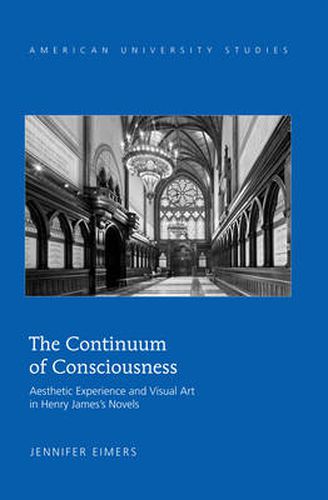Readings Newsletter
Become a Readings Member to make your shopping experience even easier.
Sign in or sign up for free!
You’re not far away from qualifying for FREE standard shipping within Australia
You’ve qualified for FREE standard shipping within Australia
The cart is loading…






This title is printed to order. This book may have been self-published. If so, we cannot guarantee the quality of the content. In the main most books will have gone through the editing process however some may not. We therefore suggest that you be aware of this before ordering this book. If in doubt check either the author or publisher’s details as we are unable to accept any returns unless they are faulty. Please contact us if you have any questions.
The Continuum of Consciousness: Aesthetic Experience and Visual Art in Henry James’s Novels examines the transformative experience of art in James’s fiction. In a 1915 letter to H. G. Wells, James declares, It is art that makes life. This book traces the rich implications of this claim. For James, viewing art transformed the self. Many of his contemporaries, including his famous older brother, William, were deeply interested in the study of perception and individual consciousness. James’s fictional use of art reflects these philosophical discussions. Although much valuable scholarship has been devoted to visual art in James’s fiction, the guiding role it often plays in his characters’ experiences receives fuller exploration in this book. A prolonged look at visual art and consciousness through the lens of nineteenth-century British aestheticism reveals intriguing connections and character responses. By highlighting and analyzing his representations of aesthetic consciousness in four novels at specific moments (such as Basil Ransom’s and Verena Tarrant’s contrasting responses to Harvard’s Memorial Hall in The Bostonians and Milly Theale’s identification with a Bronzino painting in The Wings of the Dove), this book ultimately explores the idea that for James art represents every conscious human activity , as Wells replied to James.
$9.00 standard shipping within Australia
FREE standard shipping within Australia for orders over $100.00
Express & International shipping calculated at checkout
This title is printed to order. This book may have been self-published. If so, we cannot guarantee the quality of the content. In the main most books will have gone through the editing process however some may not. We therefore suggest that you be aware of this before ordering this book. If in doubt check either the author or publisher’s details as we are unable to accept any returns unless they are faulty. Please contact us if you have any questions.
The Continuum of Consciousness: Aesthetic Experience and Visual Art in Henry James’s Novels examines the transformative experience of art in James’s fiction. In a 1915 letter to H. G. Wells, James declares, It is art that makes life. This book traces the rich implications of this claim. For James, viewing art transformed the self. Many of his contemporaries, including his famous older brother, William, were deeply interested in the study of perception and individual consciousness. James’s fictional use of art reflects these philosophical discussions. Although much valuable scholarship has been devoted to visual art in James’s fiction, the guiding role it often plays in his characters’ experiences receives fuller exploration in this book. A prolonged look at visual art and consciousness through the lens of nineteenth-century British aestheticism reveals intriguing connections and character responses. By highlighting and analyzing his representations of aesthetic consciousness in four novels at specific moments (such as Basil Ransom’s and Verena Tarrant’s contrasting responses to Harvard’s Memorial Hall in The Bostonians and Milly Theale’s identification with a Bronzino painting in The Wings of the Dove), this book ultimately explores the idea that for James art represents every conscious human activity , as Wells replied to James.